
litellm
Python SDK, Proxy Server (LLM Gateway) to call 100+ LLM APIs in OpenAI format - [Bedrock, Azure, OpenAI, VertexAI, Cohere, Anthropic, Sagemaker, HuggingFace, Replicate, Groq]
Stars: 29334
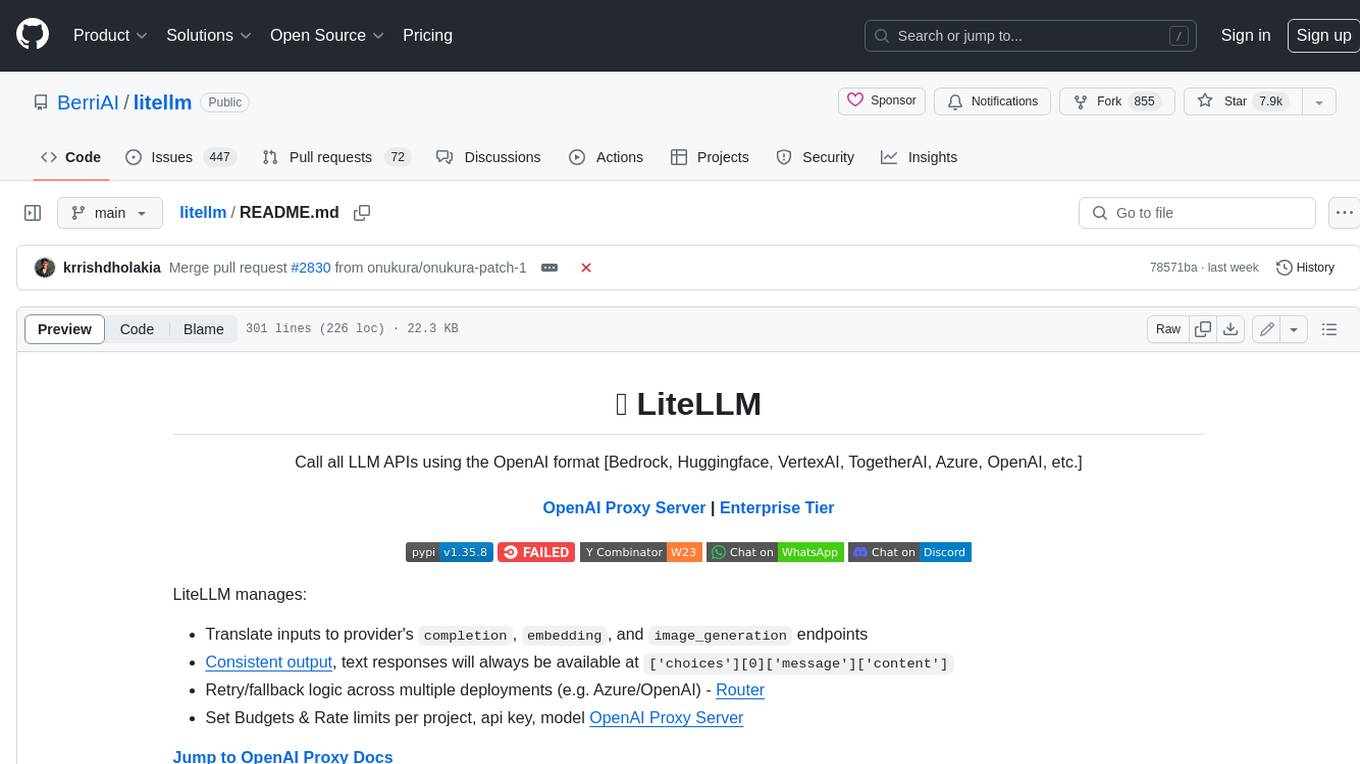
LiteLLM is a tool that allows you to call all LLM APIs using the OpenAI format. This includes Bedrock, Huggingface, VertexAI, TogetherAI, Azure, OpenAI, and more. LiteLLM manages translating inputs to provider's `completion`, `embedding`, and `image_generation` endpoints, providing consistent output, and retry/fallback logic across multiple deployments. It also supports setting budgets and rate limits per project, api key, and model.
README:
Call all LLM APIs using the OpenAI format [Bedrock, Huggingface, VertexAI, TogetherAI, Azure, OpenAI, Groq etc.]
LiteLLM manages:
- Translate inputs to provider's
completion,embedding, andimage_generationendpoints -
Consistent output, text responses will always be available at
['choices'][0]['message']['content'] - Retry/fallback logic across multiple deployments (e.g. Azure/OpenAI) - Router
- Set Budgets & Rate limits per project, api key, model LiteLLM Proxy Server (LLM Gateway)
Jump to LiteLLM Proxy (LLM Gateway) Docs
Jump to Supported LLM Providers
🚨 Stable Release: Use docker images with the -stable tag. These have undergone 12 hour load tests, before being published. More information about the release cycle here
Support for more providers. Missing a provider or LLM Platform, raise a feature request.
Usage (Docs)
[!IMPORTANT] LiteLLM v1.0.0 now requires
openai>=1.0.0. Migration guide here LiteLLM v1.40.14+ now requirespydantic>=2.0.0. No changes required.
pip install litellmfrom litellm import completion
import os
## set ENV variables
os.environ["OPENAI_API_KEY"] = "your-openai-key"
os.environ["ANTHROPIC_API_KEY"] = "your-anthropic-key"
messages = [{ "content": "Hello, how are you?","role": "user"}]
# openai call
response = completion(model="openai/gpt-4o", messages=messages)
# anthropic call
response = completion(model="anthropic/claude-sonnet-4-20250514", messages=messages)
print(response){
"id": "chatcmpl-1214900a-6cdd-4148-b663-b5e2f642b4de",
"created": 1751494488,
"model": "claude-sonnet-4-20250514",
"object": "chat.completion",
"system_fingerprint": null,
"choices": [
{
"finish_reason": "stop",
"index": 0,
"message": {
"content": "Hello! I'm doing well, thank you for asking. I'm here and ready to help with whatever you'd like to discuss or work on. How are you doing today?",
"role": "assistant",
"tool_calls": null,
"function_call": null
}
}
],
"usage": {
"completion_tokens": 39,
"prompt_tokens": 13,
"total_tokens": 52,
"completion_tokens_details": null,
"prompt_tokens_details": {
"audio_tokens": null,
"cached_tokens": 0
},
"cache_creation_input_tokens": 0,
"cache_read_input_tokens": 0
}
}Call any model supported by a provider, with model=<provider_name>/<model_name>. There might be provider-specific details here, so refer to provider docs for more information
Async (Docs)
from litellm import acompletion
import asyncio
async def test_get_response():
user_message = "Hello, how are you?"
messages = [{"content": user_message, "role": "user"}]
response = await acompletion(model="openai/gpt-4o", messages=messages)
return response
response = asyncio.run(test_get_response())
print(response)Streaming (Docs)
liteLLM supports streaming the model response back, pass stream=True to get a streaming iterator in response.
Streaming is supported for all models (Bedrock, Huggingface, TogetherAI, Azure, OpenAI, etc.)
from litellm import completion
response = completion(model="openai/gpt-4o", messages=messages, stream=True)
for part in response:
print(part.choices[0].delta.content or "")
# claude sonnet 4
response = completion('anthropic/claude-sonnet-4-20250514', messages, stream=True)
for part in response:
print(part){
"id": "chatcmpl-fe575c37-5004-4926-ae5e-bfbc31f356ca",
"created": 1751494808,
"model": "claude-sonnet-4-20250514",
"object": "chat.completion.chunk",
"system_fingerprint": null,
"choices": [
{
"finish_reason": null,
"index": 0,
"delta": {
"provider_specific_fields": null,
"content": "Hello",
"role": "assistant",
"function_call": null,
"tool_calls": null,
"audio": null
},
"logprobs": null
}
],
"provider_specific_fields": null,
"stream_options": null,
"citations": null
}Logging Observability (Docs)
LiteLLM exposes pre defined callbacks to send data to Lunary, MLflow, Langfuse, DynamoDB, s3 Buckets, Helicone, Promptlayer, Traceloop, Athina, Slack
from litellm import completion
## set env variables for logging tools (when using MLflow, no API key set up is required)
os.environ["LUNARY_PUBLIC_KEY"] = "your-lunary-public-key"
os.environ["HELICONE_API_KEY"] = "your-helicone-auth-key"
os.environ["LANGFUSE_PUBLIC_KEY"] = ""
os.environ["LANGFUSE_SECRET_KEY"] = ""
os.environ["ATHINA_API_KEY"] = "your-athina-api-key"
os.environ["OPENAI_API_KEY"] = "your-openai-key"
# set callbacks
litellm.success_callback = ["lunary", "mlflow", "langfuse", "athina", "helicone"] # log input/output to lunary, langfuse, supabase, athina, helicone etc
#openai call
response = completion(model="openai/gpt-4o", messages=[{"role": "user", "content": "Hi 👋 - i'm openai"}])LiteLLM Proxy Server (LLM Gateway) - (Docs)
Track spend + Load Balance across multiple projects
The proxy provides:
📖 Proxy Endpoints - Swagger Docs
pip install 'litellm[proxy]'$ litellm --model huggingface/bigcode/starcoder
#INFO: Proxy running on http://0.0.0.0:4000[!IMPORTANT] 💡 Use LiteLLM Proxy with Langchain (Python, JS), OpenAI SDK (Python, JS) Anthropic SDK, Mistral SDK, LlamaIndex, Instructor, Curl
import openai # openai v1.0.0+
client = openai.OpenAI(api_key="anything",base_url="http://0.0.0.0:4000") # set proxy to base_url
# request sent to model set on litellm proxy, `litellm --model`
response = client.chat.completions.create(model="gpt-3.5-turbo", messages = [
{
"role": "user",
"content": "this is a test request, write a short poem"
}
])
print(response)Proxy Key Management (Docs)
Connect the proxy with a Postgres DB to create proxy keys
# Get the code
git clone https://github.com/BerriAI/litellm
# Go to folder
cd litellm
# Add the master key - you can change this after setup
echo 'LITELLM_MASTER_KEY="sk-1234"' > .env
# Add the litellm salt key - you cannot change this after adding a model
# It is used to encrypt / decrypt your LLM API Key credentials
# We recommend - https://1password.com/password-generator/
# password generator to get a random hash for litellm salt key
echo 'LITELLM_SALT_KEY="sk-1234"' >> .env
source .env
# Start
docker-compose upUI on /ui on your proxy server
Set budgets and rate limits across multiple projects
POST /key/generate
curl 'http://0.0.0.0:4000/key/generate' \
--header 'Authorization: Bearer sk-1234' \
--header 'Content-Type: application/json' \
--data-raw '{"models": ["gpt-3.5-turbo", "gpt-4", "claude-2"], "duration": "20m","metadata": {"user": "[email protected]", "team": "core-infra"}}'{
"key": "sk-kdEXbIqZRwEeEiHwdg7sFA", # Bearer token
"expires": "2023-11-19T01:38:25.838000+00:00" # datetime object
}Supported Providers (Docs)
| Provider | Completion | Streaming | Async Completion | Async Streaming | Async Embedding | Async Image Generation |
|---|---|---|---|---|---|---|
| openai | ✅ | ✅ | ✅ | ✅ | ✅ | ✅ |
| Meta - Llama API | ✅ | ✅ | ✅ | ✅ | ||
| azure | ✅ | ✅ | ✅ | ✅ | ✅ | ✅ |
| AI/ML API | ✅ | ✅ | ✅ | ✅ | ✅ | ✅ |
| aws - sagemaker | ✅ | ✅ | ✅ | ✅ | ✅ | |
| aws - bedrock | ✅ | ✅ | ✅ | ✅ | ✅ | |
| google - vertex_ai | ✅ | ✅ | ✅ | ✅ | ✅ | ✅ |
| google - palm | ✅ | ✅ | ✅ | ✅ | ||
| google AI Studio - gemini | ✅ | ✅ | ✅ | ✅ | ||
| mistral ai api | ✅ | ✅ | ✅ | ✅ | ✅ | |
| cloudflare AI Workers | ✅ | ✅ | ✅ | ✅ | ||
| CompactifAI | ✅ | ✅ | ✅ | ✅ | ||
| cohere | ✅ | ✅ | ✅ | ✅ | ✅ | |
| anthropic | ✅ | ✅ | ✅ | ✅ | ||
| empower | ✅ | ✅ | ✅ | ✅ | ||
| huggingface | ✅ | ✅ | ✅ | ✅ | ✅ | |
| replicate | ✅ | ✅ | ✅ | ✅ | ||
| together_ai | ✅ | ✅ | ✅ | ✅ | ||
| openrouter | ✅ | ✅ | ✅ | ✅ | ||
| ai21 | ✅ | ✅ | ✅ | ✅ | ||
| baseten | ✅ | ✅ | ✅ | ✅ | ||
| vllm | ✅ | ✅ | ✅ | ✅ | ||
| nlp_cloud | ✅ | ✅ | ✅ | ✅ | ||
| aleph alpha | ✅ | ✅ | ✅ | ✅ | ||
| petals | ✅ | ✅ | ✅ | ✅ | ||
| ollama | ✅ | ✅ | ✅ | ✅ | ✅ | |
| deepinfra | ✅ | ✅ | ✅ | ✅ | ||
| perplexity-ai | ✅ | ✅ | ✅ | ✅ | ||
| Groq AI | ✅ | ✅ | ✅ | ✅ | ||
| Deepseek | ✅ | ✅ | ✅ | ✅ | ||
| anyscale | ✅ | ✅ | ✅ | ✅ | ||
| IBM - watsonx.ai | ✅ | ✅ | ✅ | ✅ | ✅ | |
| voyage ai | ✅ | |||||
| xinference [Xorbits Inference] | ✅ | |||||
| FriendliAI | ✅ | ✅ | ✅ | ✅ | ||
| Galadriel | ✅ | ✅ | ✅ | ✅ | ||
| GradientAI | ✅ | ✅ | ||||
| Novita AI | ✅ | ✅ | ✅ | ✅ | ||
| Featherless AI | ✅ | ✅ | ✅ | ✅ | ||
| Nebius AI Studio | ✅ | ✅ | ✅ | ✅ | ✅ | |
| Heroku | ✅ | ✅ | ||||
| OVHCloud AI Endpoints | ✅ | ✅ |
- Setup .env file in root
- Run dependant services
docker-compose up db prometheus
- (In root) create virtual environment
python -m venv .venv - Activate virtual environment
source .venv/bin/activate - Install dependencies
pip install -e ".[all]" - Start proxy backend
python litellm/proxy_cli.py
- Navigate to
ui/litellm-dashboard - Install dependencies
npm install - Run
npm run devto start the dashboard
For companies that need better security, user management and professional support
This covers:
- ✅ Features under the LiteLLM Commercial License:
- ✅ Feature Prioritization
- ✅ Custom Integrations
- ✅ Professional Support - Dedicated discord + slack
- ✅ Custom SLAs
- ✅ Secure access with Single Sign-On
We welcome contributions to LiteLLM! Whether you're fixing bugs, adding features, or improving documentation, we appreciate your help.
This requires poetry to be installed.
git clone https://github.com/BerriAI/litellm.git
cd litellm
make install-dev # Install development dependencies
make format # Format your code
make lint # Run all linting checks
make test-unit # Run unit tests
make format-check # Check formatting onlyFor detailed contributing guidelines, see CONTRIBUTING.md.
LiteLLM follows the Google Python Style Guide.
Our automated checks include:
- Black for code formatting
- Ruff for linting and code quality
- MyPy for type checking
- Circular import detection
- Import safety checks
All these checks must pass before your PR can be merged.
- Schedule Demo 👋
- Community Discord 💭
- Community Slack 💭
- Our numbers 📞 +1 (770) 8783-106 / +1 (412) 618-6238
- Our emails ✉️ [email protected] / [email protected]
- Need for simplicity: Our code started to get extremely complicated managing & translating calls between Azure, OpenAI and Cohere.
For Tasks:
Click tags to check more tools for each tasksFor Jobs:
Alternative AI tools for litellm
Similar Open Source Tools

litellm
LiteLLM is a tool that allows you to call all LLM APIs using the OpenAI format. This includes Bedrock, Huggingface, VertexAI, TogetherAI, Azure, OpenAI, and more. LiteLLM manages translating inputs to provider's `completion`, `embedding`, and `image_generation` endpoints, providing consistent output, and retry/fallback logic across multiple deployments. It also supports setting budgets and rate limits per project, api key, and model.
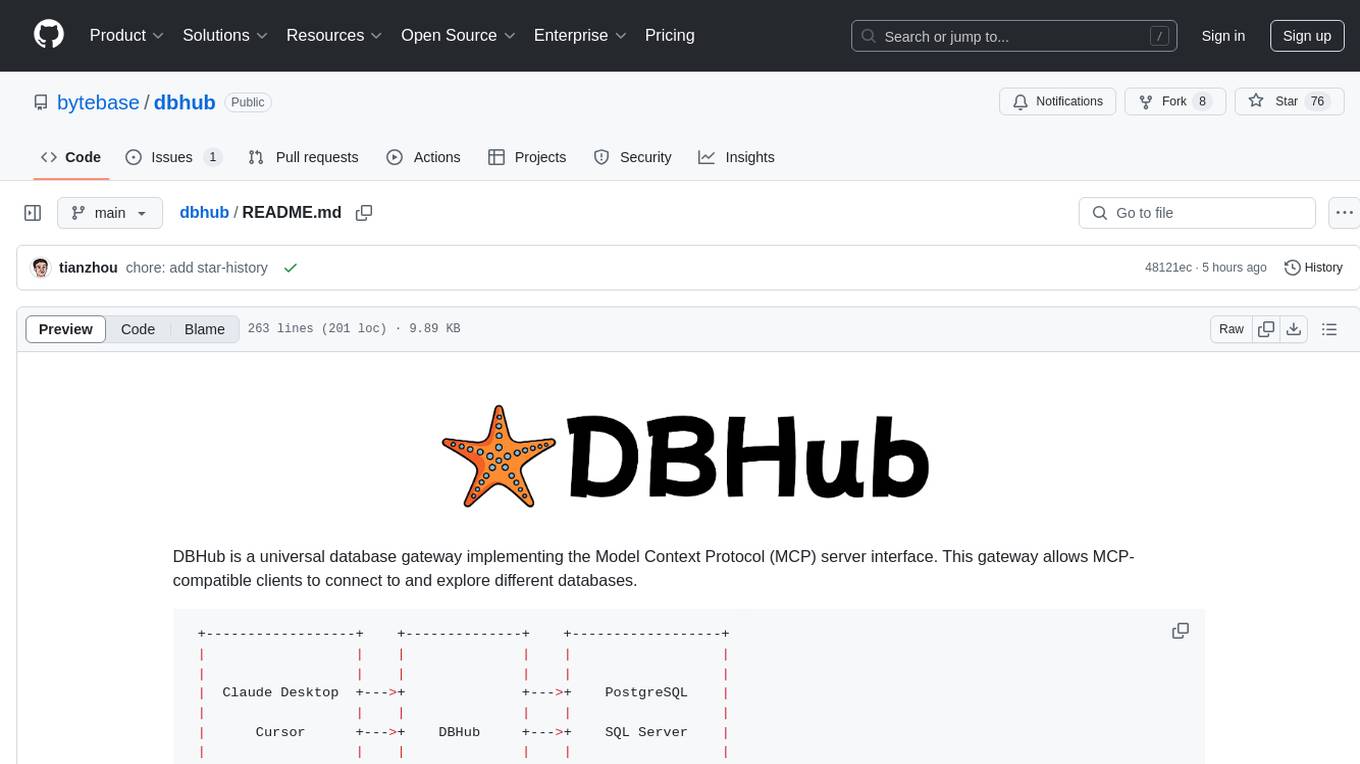
dbhub
DBHub is a universal database gateway that implements the Model Context Protocol (MCP) server interface. It allows MCP-compatible clients to connect to and explore different databases. The gateway supports various database resources and tools, providing capabilities such as executing queries, listing connectors, generating SQL, and explaining database elements. Users can easily configure their database connections and choose between different transport modes like stdio and sse. DBHub also offers a demo mode with a sample employee database for testing purposes.
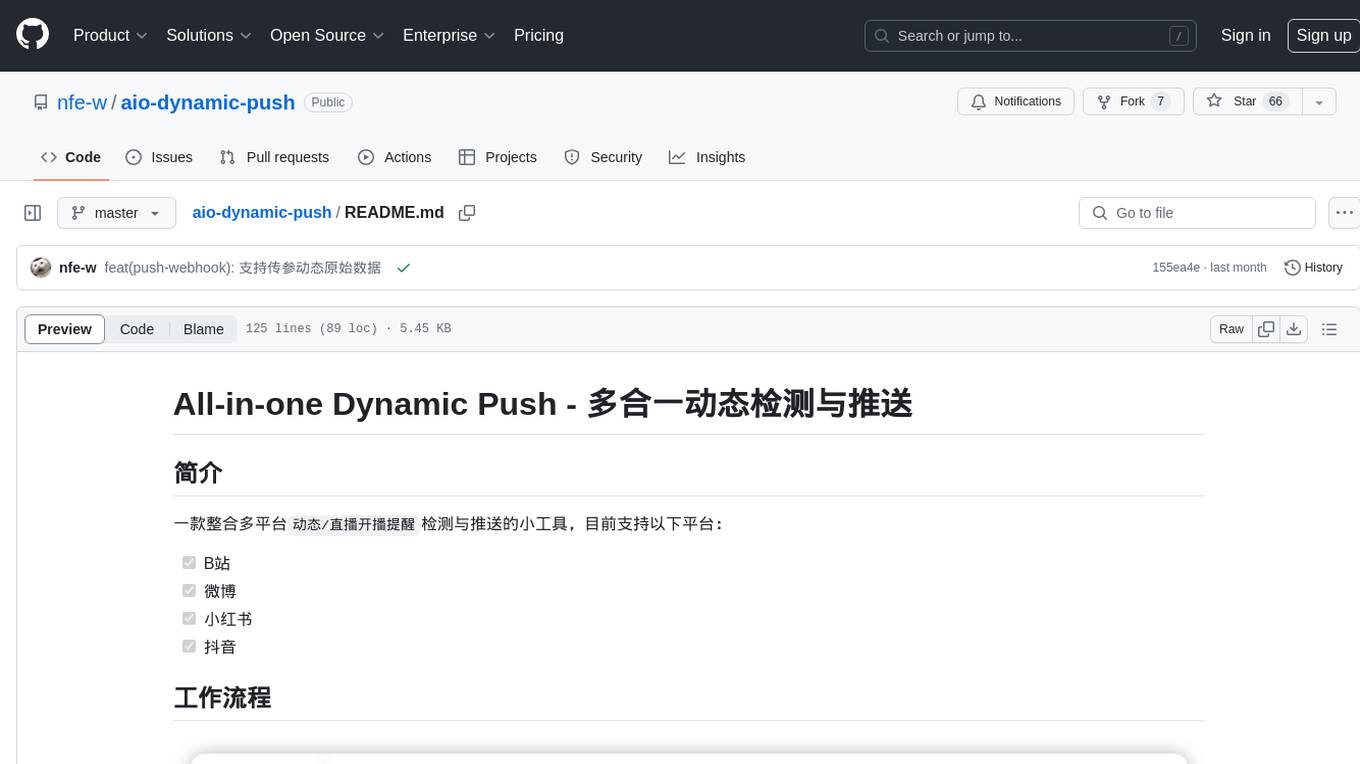
aio-dynamic-push
Aio-dynamic-push is a tool that integrates multiple platforms for dynamic/live streaming alerts detection and push notifications. It currently supports platforms such as Bilibili, Weibo, Xiaohongshu, and Douyin. Users can configure different tasks and push channels in the config file to receive notifications. The tool is designed to simplify the process of monitoring and receiving alerts from various social media platforms, making it convenient for users to stay updated on their favorite content creators or accounts.
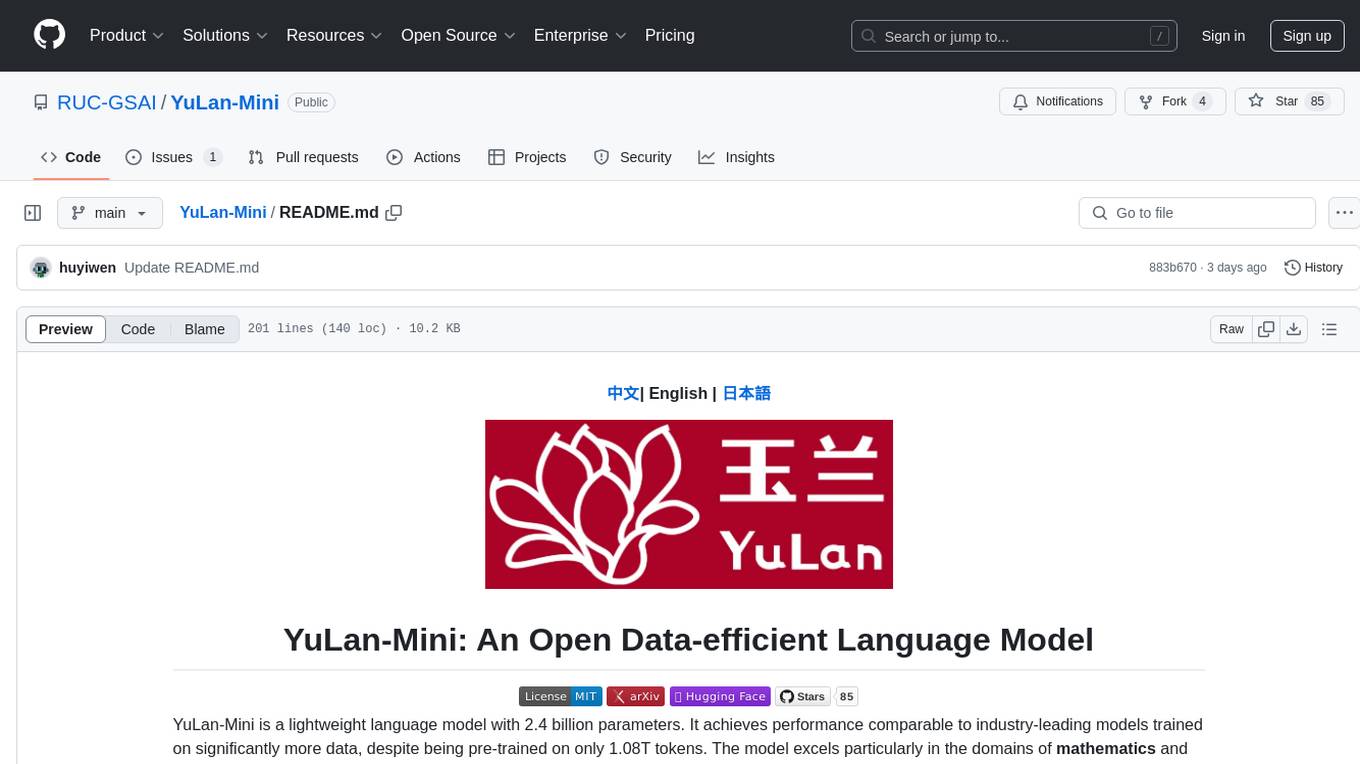
YuLan-Mini
YuLan-Mini is a lightweight language model with 2.4 billion parameters that achieves performance comparable to industry-leading models despite being pre-trained on only 1.08T tokens. It excels in mathematics and code domains. The repository provides pre-training resources, including data pipeline, optimization methods, and annealing approaches. Users can pre-train their own language models, perform learning rate annealing, fine-tune the model, research training dynamics, and synthesize data. The team behind YuLan-Mini is AI Box at Renmin University of China. The code is released under the MIT License with future updates on model weights usage policies. Users are advised on potential safety concerns and ethical use of the model.
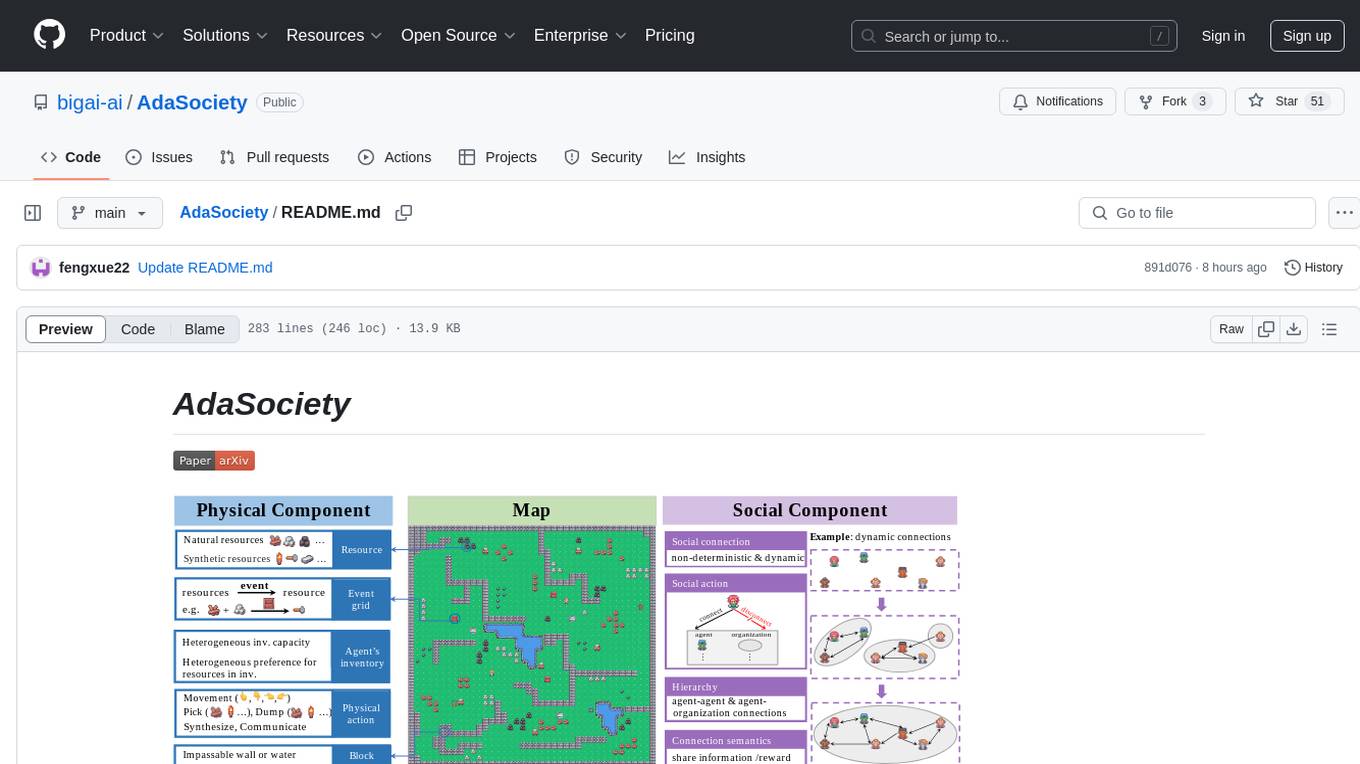
AdaSociety
AdaSociety is a multi-agent environment designed for simulating social structures and decision-making processes. It offers built-in resources, events, and player interactions. Users can customize the environment through JSON configuration or custom Python code. The environment supports training agents using RLlib and LLM frameworks. It provides a platform for studying multi-agent systems and social dynamics.
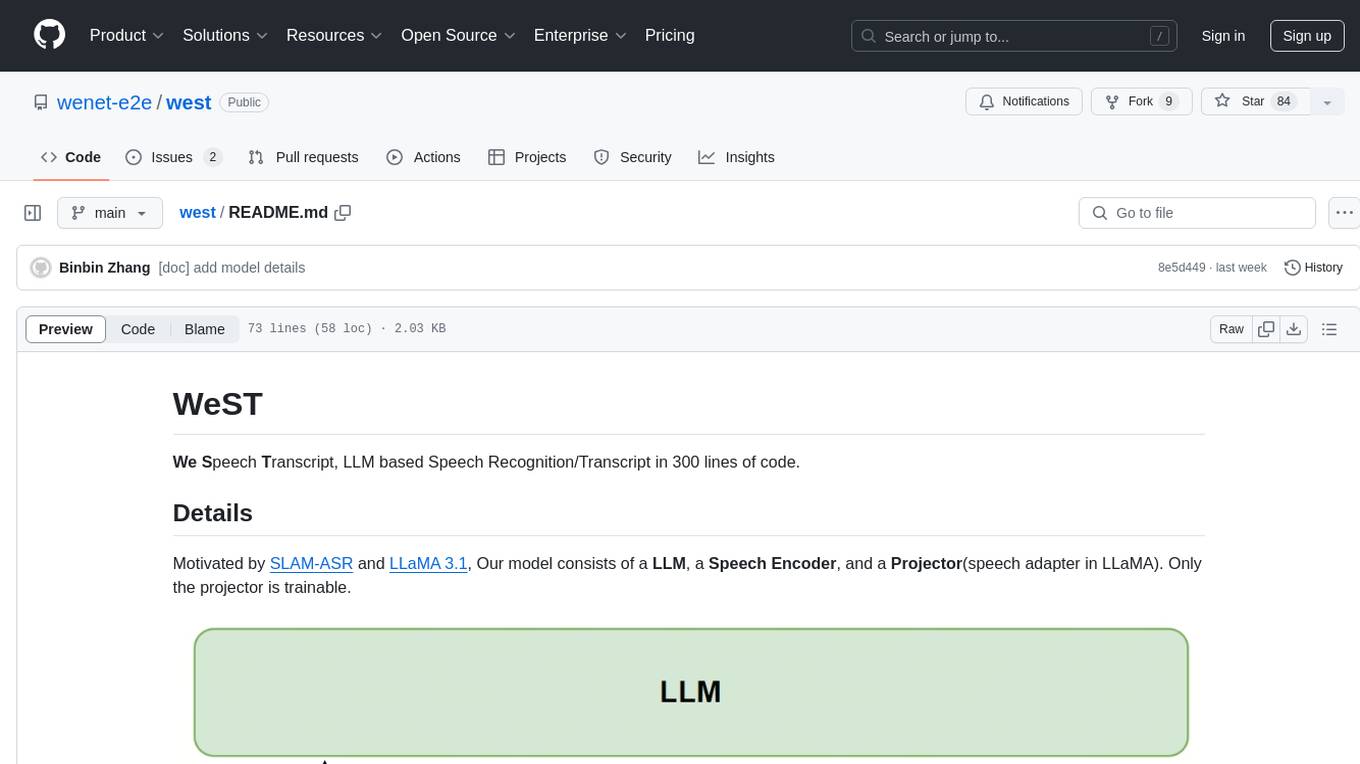
west
WeST is a Speech Recognition/Transcript tool developed in 300 lines of code, inspired by SLAM-ASR and LLaMA 3.1. The model includes a Language Model (LLM), a Speech Encoder, and a trainable Projector. It requires training data in jsonl format with 'wav' and 'txt' entries. WeST can be used for training and decoding speech recognition models.
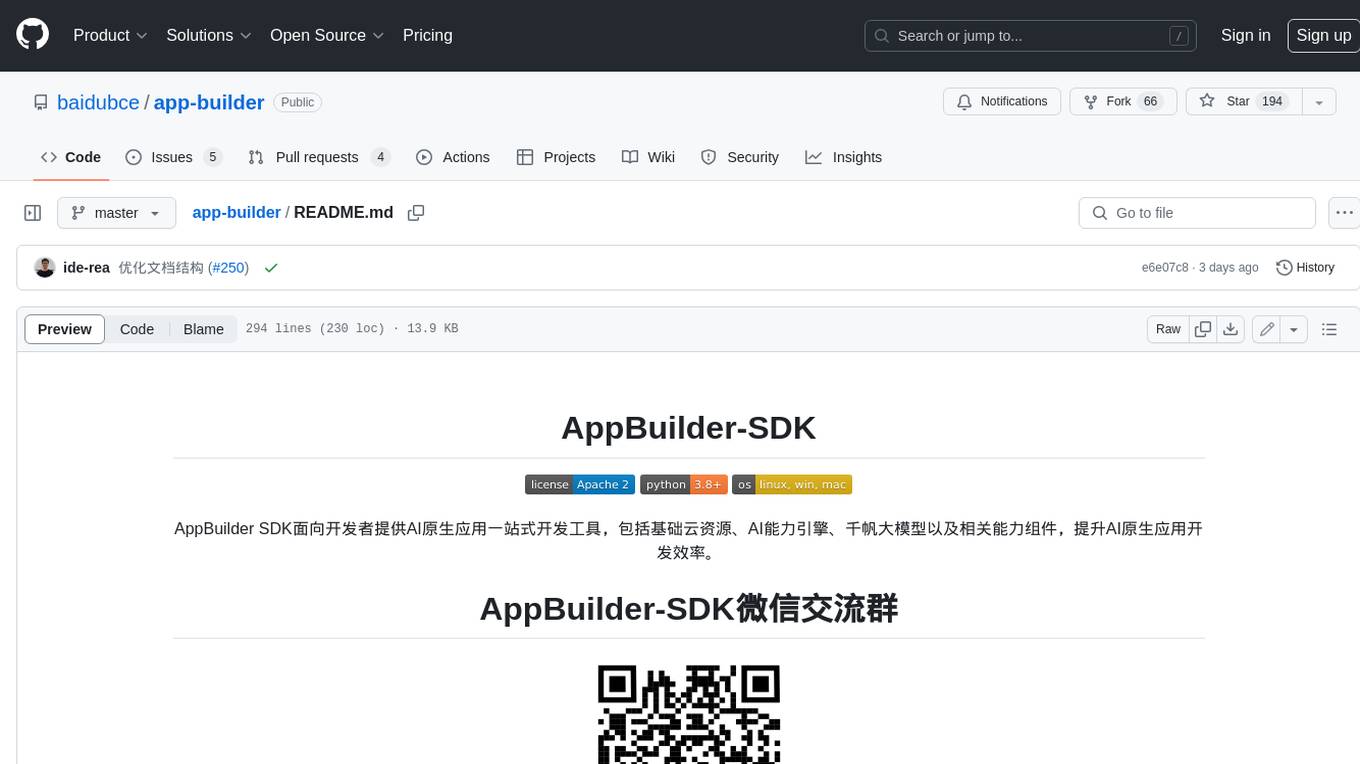
app-builder
AppBuilder SDK is a one-stop development tool for AI native applications, providing basic cloud resources, AI capability engine, Qianfan large model, and related capability components to improve the development efficiency of AI native applications.
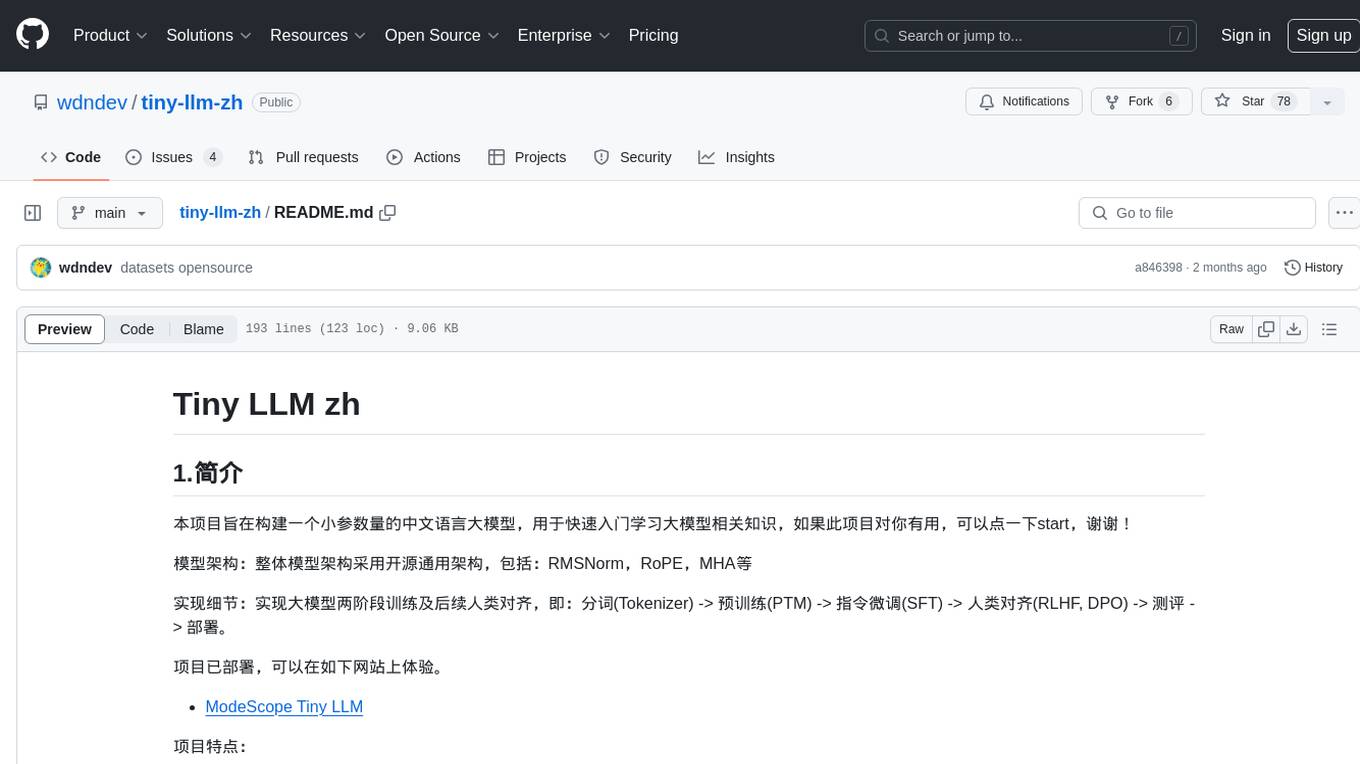
tiny-llm-zh
Tiny LLM zh is a project aimed at building a small-parameter Chinese language large model for quick entry into learning large model-related knowledge. The project implements a two-stage training process for large models and subsequent human alignment, including tokenization, pre-training, instruction fine-tuning, human alignment, evaluation, and deployment. It is deployed on ModeScope Tiny LLM website and features open access to all data and code, including pre-training data and tokenizer. The project trains a tokenizer using 10GB of Chinese encyclopedia text to build a Tiny LLM vocabulary. It supports training with Transformers deepspeed, multiple machine and card support, and Zero optimization techniques. The project has three main branches: llama2_torch, main tiny_llm, and tiny_llm_moe, each with specific modifications and features.
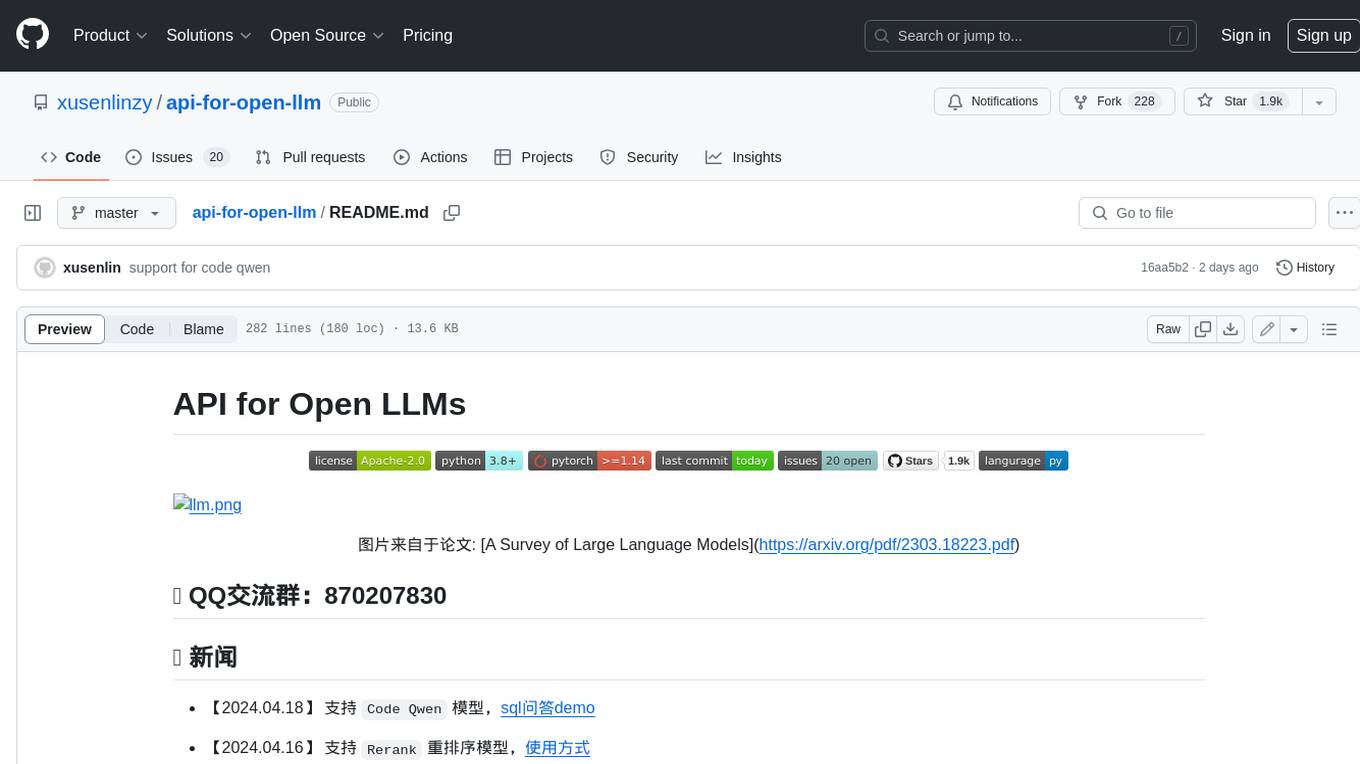
api-for-open-llm
This project provides a unified backend interface for open large language models (LLMs), offering a consistent experience with OpenAI's ChatGPT API. It supports various open-source LLMs, enabling developers to seamlessly integrate them into their applications. The interface features streaming responses, text embedding capabilities, and support for LangChain, a tool for developing LLM-based applications. By modifying environment variables, developers can easily use open-source models as alternatives to ChatGPT, providing a cost-effective and customizable solution for various use cases.
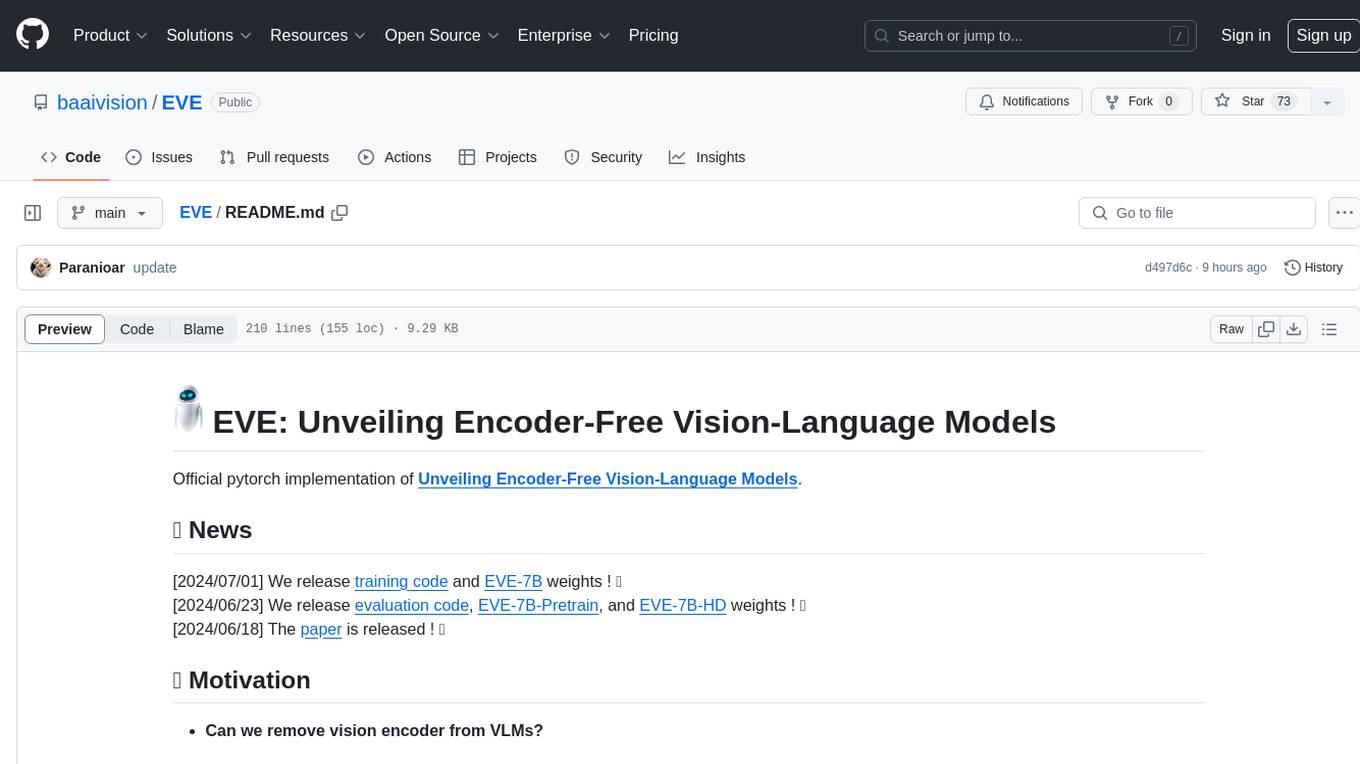
EVE
EVE is an official PyTorch implementation of Unveiling Encoder-Free Vision-Language Models. The project aims to explore the removal of vision encoders from Vision-Language Models (VLMs) and transfer LLMs to encoder-free VLMs efficiently. It also focuses on bridging the performance gap between encoder-free and encoder-based VLMs. EVE offers a superior capability with arbitrary image aspect ratio, data efficiency by utilizing publicly available data for pre-training, and training efficiency with a transparent and practical strategy for developing a pure decoder-only architecture across modalities.
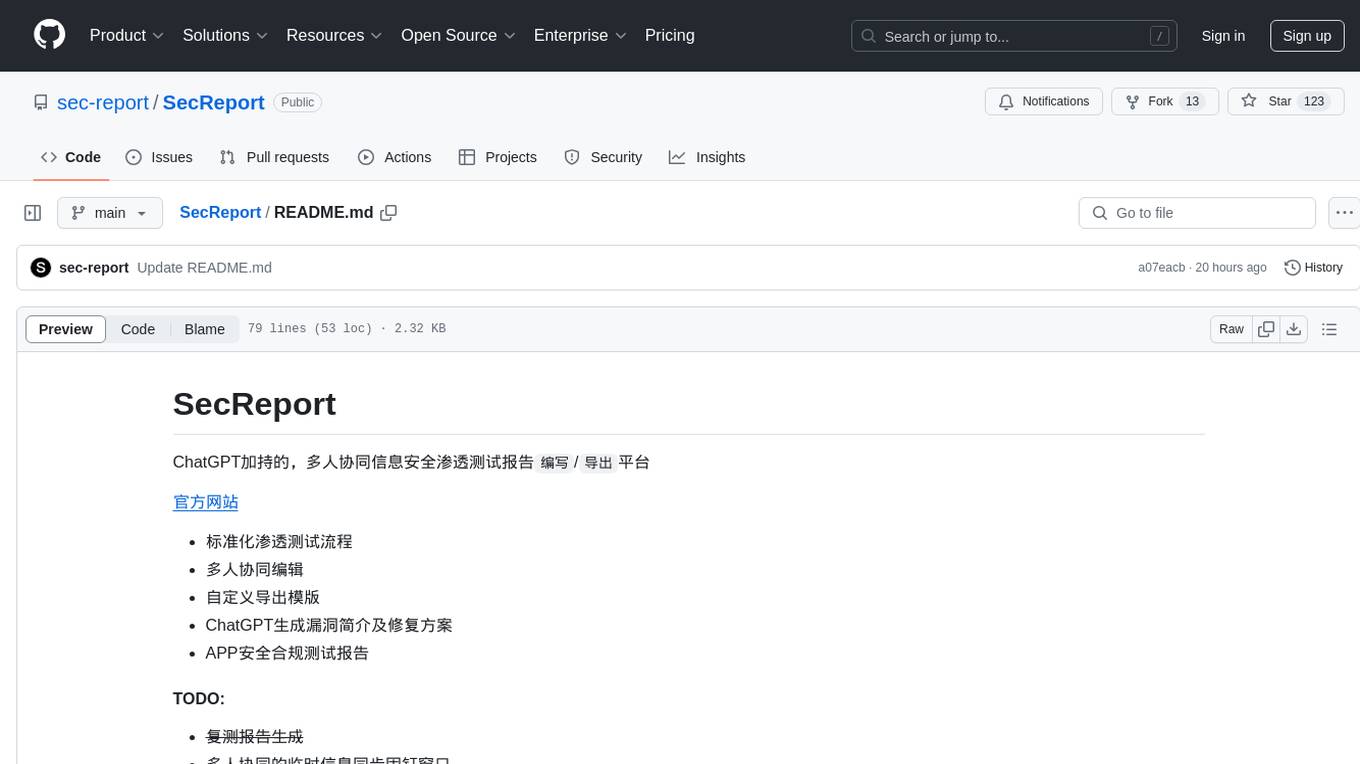
SecReport
SecReport is a platform for collaborative information security penetration testing report writing and exporting, powered by ChatGPT. It standardizes penetration testing processes, allows multiple users to edit reports, offers custom export templates, generates vulnerability summaries and fix suggestions using ChatGPT, and provides APP security compliance testing reports. The tool aims to streamline the process of creating and managing security reports for penetration testing and compliance purposes.
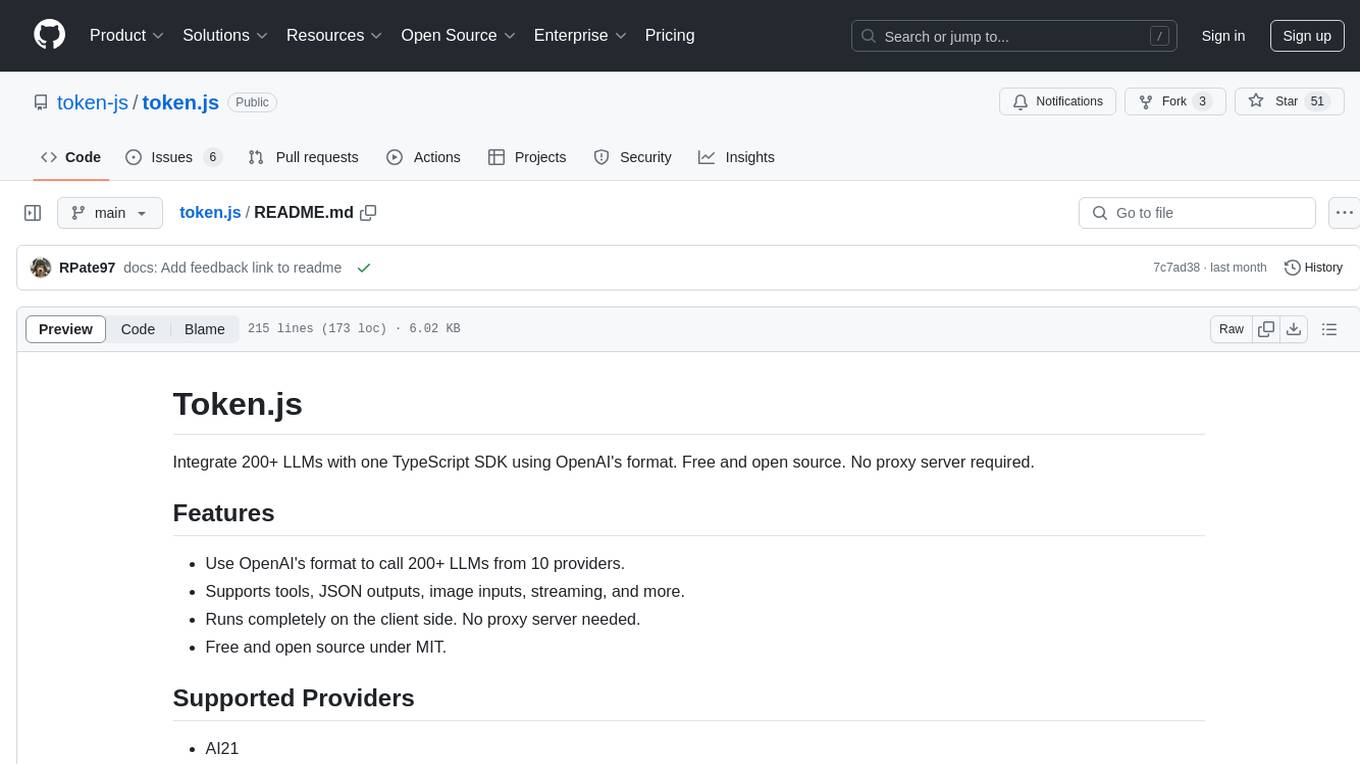
token.js
Token.js is a TypeScript SDK that integrates with over 200 LLMs from 10 providers using OpenAI's format. It allows users to call LLMs, supports tools, JSON outputs, image inputs, and streaming, all running on the client side without the need for a proxy server. The tool is free and open source under the MIT license.
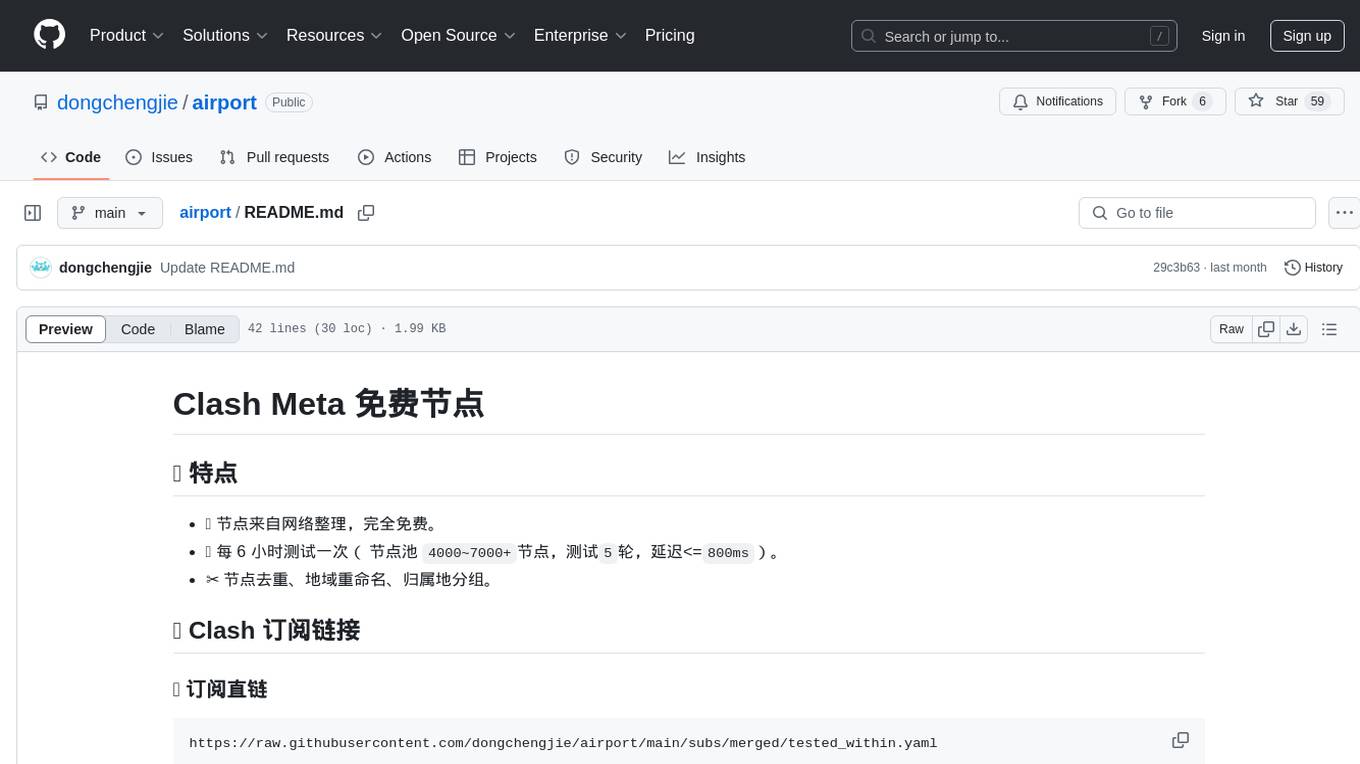
airport
The 'airport' repository provides free Clash Meta nodes sourced from the internet, with testing every 6 hours to ensure quality and low latency. It includes features such as node deduplication, regional renaming, and geographical grouping.
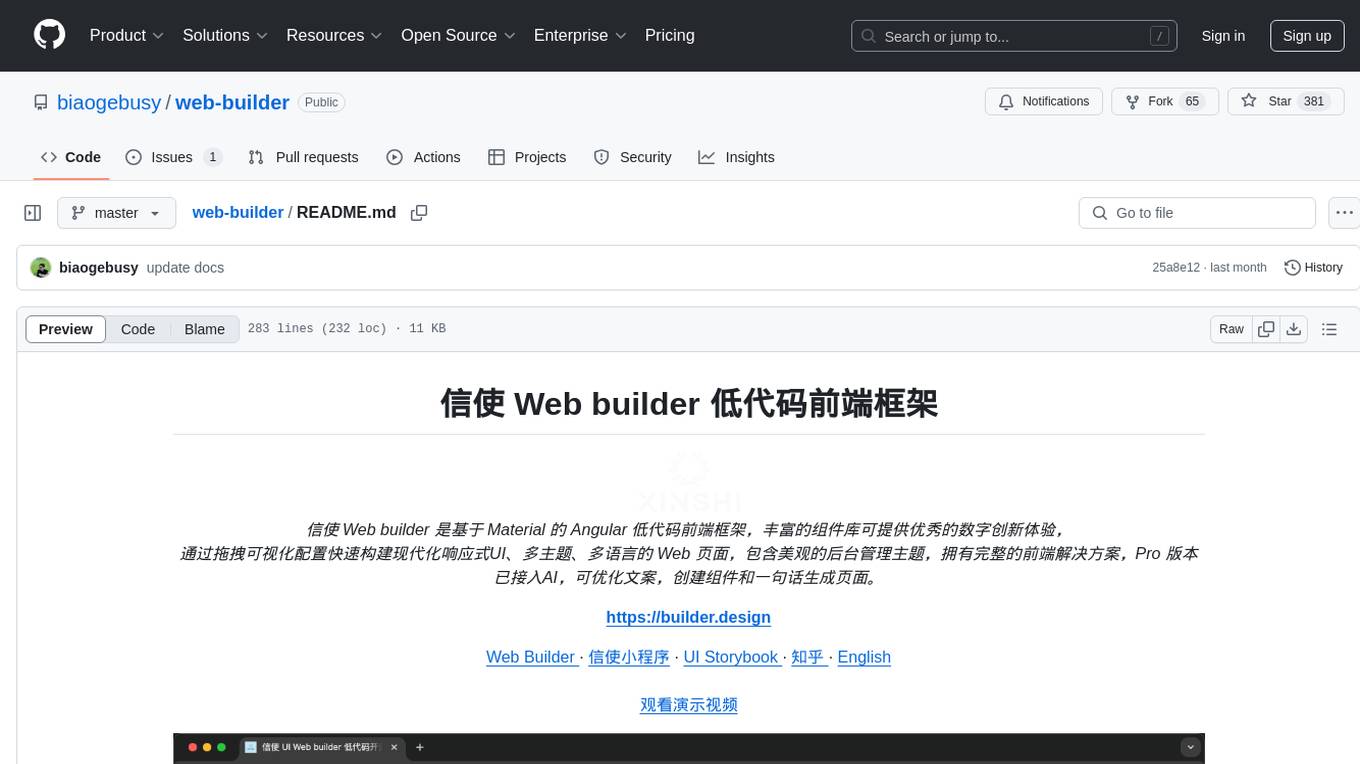
web-builder
Web Builder is a low-code front-end framework based on Material for Angular, offering a rich component library for excellent digital innovation experience. It allows rapid construction of modern responsive UI, multi-theme, multi-language web pages through drag-and-drop visual configuration. The framework includes a beautiful admin theme, complete front-end solutions, and AI integration in the Pro version for optimizing copy, creating components, and generating pages with a single sentence.
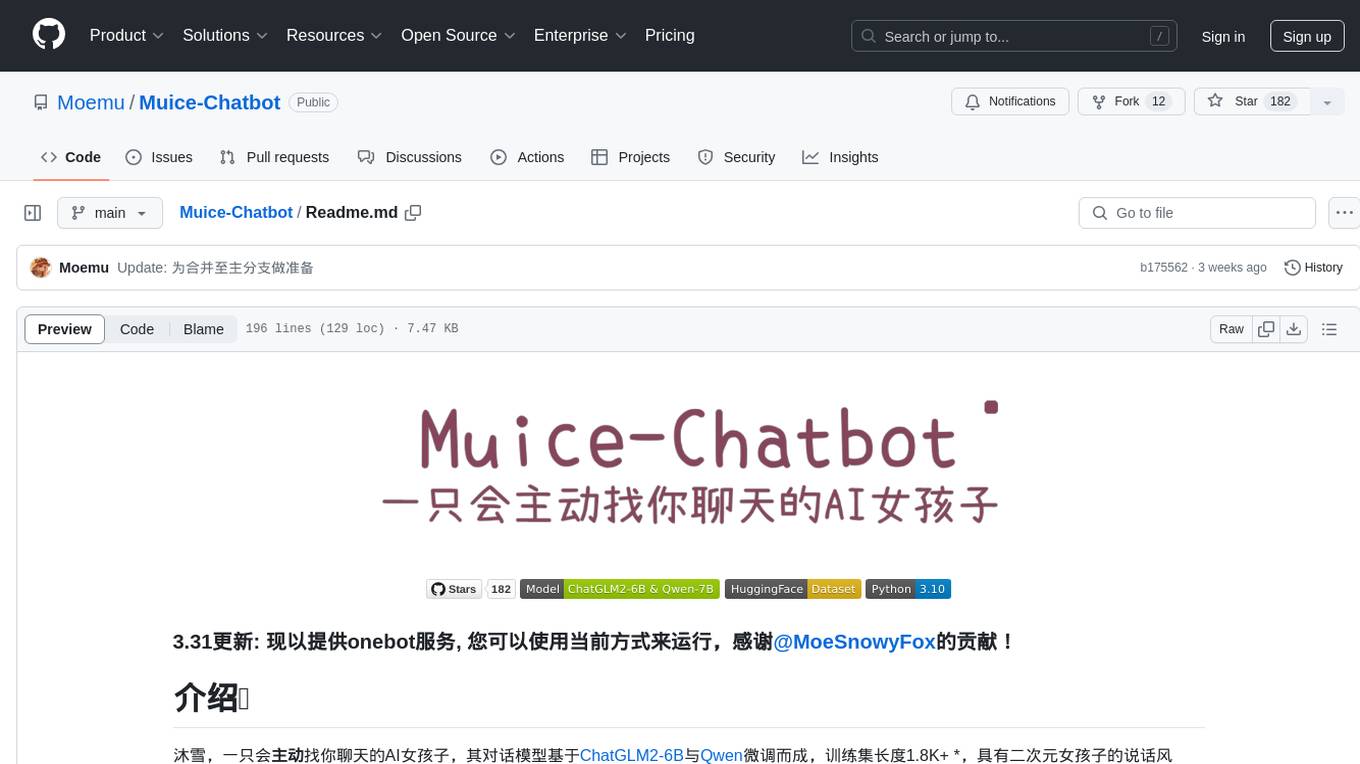
Muice-Chatbot
Muice-Chatbot is an AI chatbot designed to proactively engage in conversations with users. It is based on the ChatGLM2-6B and Qwen-7B models, with a training dataset of 1.8K+ dialogues. The chatbot has a speaking style similar to a 2D girl, being somewhat tsundere but willing to share daily life details and greet users differently every day. It provides various functionalities, including initiating chats and offering 5 available commands. The project supports model loading through different methods and provides onebot service support for QQ users. Users can interact with the chatbot by running the main.py file in the project directory.
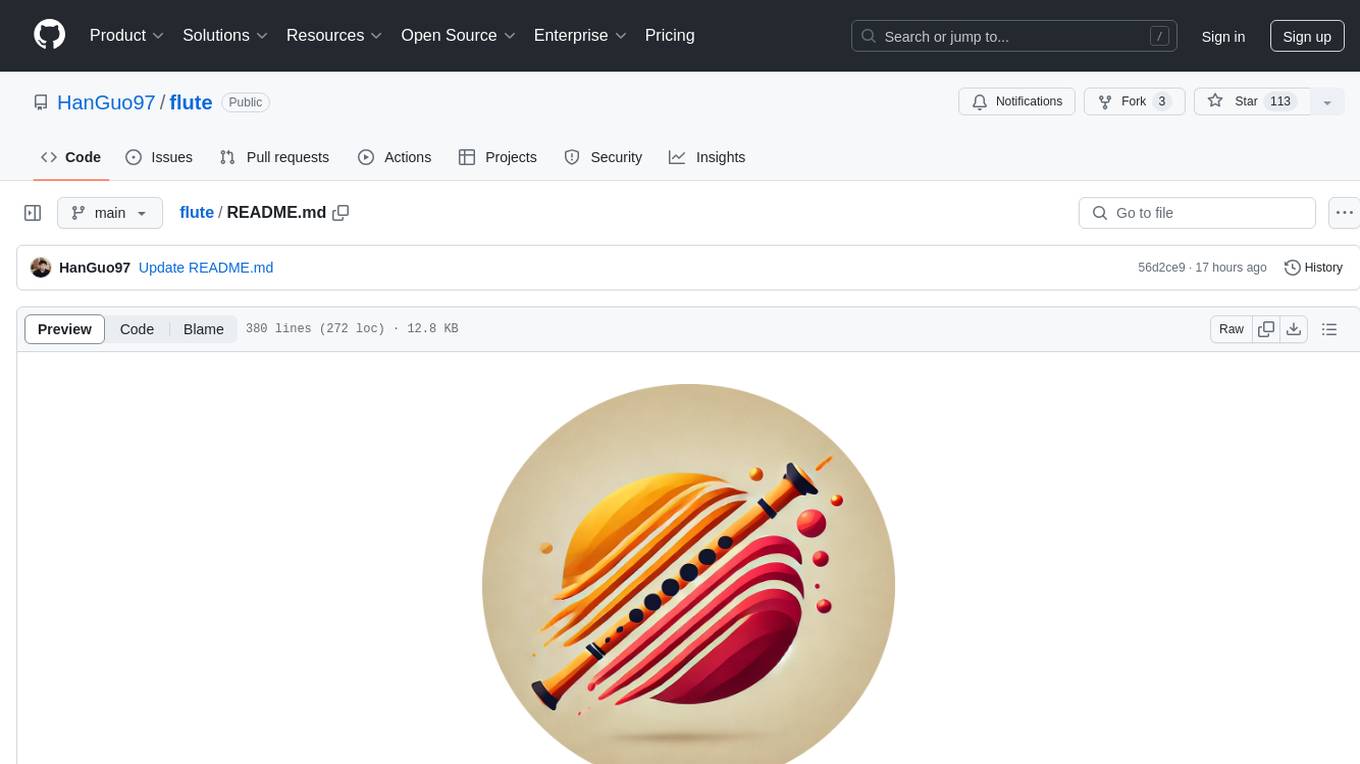
flute
FLUTE (Flexible Lookup Table Engine for LUT-quantized LLMs) is a tool designed for uniform quantization and lookup table quantization of weights in lower-precision intervals. It offers flexibility in mapping intervals to arbitrary values through a lookup table. FLUTE supports various quantization formats such as int4, int3, int2, fp4, fp3, fp2, nf4, nf3, nf2, and even custom tables. The tool also introduces new quantization algorithms like Learned Normal Float (NFL) for improved performance and calibration data learning. FLUTE provides benchmarks, model zoo, and integration with frameworks like vLLM and HuggingFace for easy deployment and usage.
For similar tasks

LLMStack
LLMStack is a no-code platform for building generative AI agents, workflows, and chatbots. It allows users to connect their own data, internal tools, and GPT-powered models without any coding experience. LLMStack can be deployed to the cloud or on-premise and can be accessed via HTTP API or triggered from Slack or Discord.

ai-guide
This guide is dedicated to Large Language Models (LLMs) that you can run on your home computer. It assumes your PC is a lower-end, non-gaming setup.

onnxruntime-genai
ONNX Runtime Generative AI is a library that provides the generative AI loop for ONNX models, including inference with ONNX Runtime, logits processing, search and sampling, and KV cache management. Users can call a high level `generate()` method, or run each iteration of the model in a loop. It supports greedy/beam search and TopP, TopK sampling to generate token sequences, has built in logits processing like repetition penalties, and allows for easy custom scoring.

jupyter-ai
Jupyter AI connects generative AI with Jupyter notebooks. It provides a user-friendly and powerful way to explore generative AI models in notebooks and improve your productivity in JupyterLab and the Jupyter Notebook. Specifically, Jupyter AI offers: * An `%%ai` magic that turns the Jupyter notebook into a reproducible generative AI playground. This works anywhere the IPython kernel runs (JupyterLab, Jupyter Notebook, Google Colab, Kaggle, VSCode, etc.). * A native chat UI in JupyterLab that enables you to work with generative AI as a conversational assistant. * Support for a wide range of generative model providers, including AI21, Anthropic, AWS, Cohere, Gemini, Hugging Face, NVIDIA, and OpenAI. * Local model support through GPT4All, enabling use of generative AI models on consumer grade machines with ease and privacy.
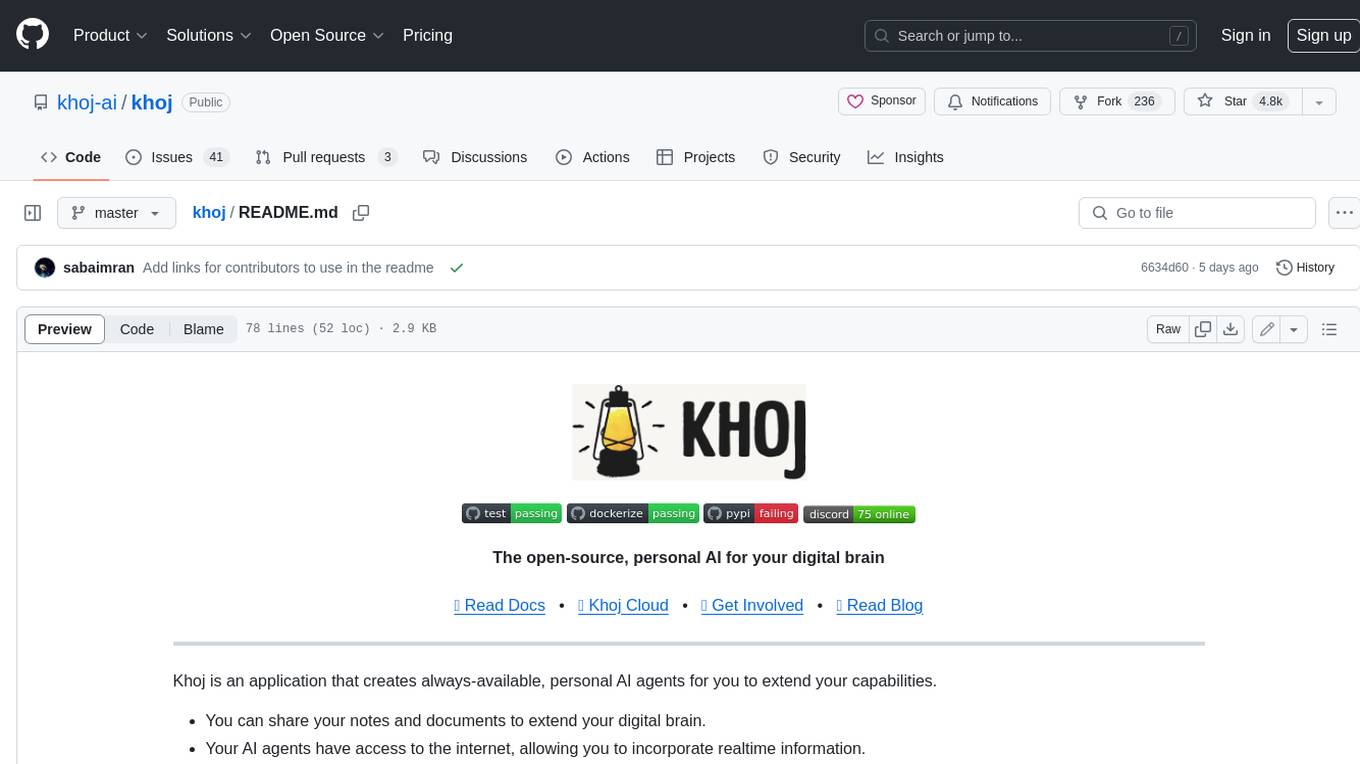
khoj
Khoj is an open-source, personal AI assistant that extends your capabilities by creating always-available AI agents. You can share your notes and documents to extend your digital brain, and your AI agents have access to the internet, allowing you to incorporate real-time information. Khoj is accessible on Desktop, Emacs, Obsidian, Web, and Whatsapp, and you can share PDF, markdown, org-mode, notion files, and GitHub repositories. You'll get fast, accurate semantic search on top of your docs, and your agents can create deeply personal images and understand your speech. Khoj is self-hostable and always will be.

langchain_dart
LangChain.dart is a Dart port of the popular LangChain Python framework created by Harrison Chase. LangChain provides a set of ready-to-use components for working with language models and a standard interface for chaining them together to formulate more advanced use cases (e.g. chatbots, Q&A with RAG, agents, summarization, extraction, etc.). The components can be grouped into a few core modules: * **Model I/O:** LangChain offers a unified API for interacting with various LLM providers (e.g. OpenAI, Google, Mistral, Ollama, etc.), allowing developers to switch between them with ease. Additionally, it provides tools for managing model inputs (prompt templates and example selectors) and parsing the resulting model outputs (output parsers). * **Retrieval:** assists in loading user data (via document loaders), transforming it (with text splitters), extracting its meaning (using embedding models), storing (in vector stores) and retrieving it (through retrievers) so that it can be used to ground the model's responses (i.e. Retrieval-Augmented Generation or RAG). * **Agents:** "bots" that leverage LLMs to make informed decisions about which available tools (such as web search, calculators, database lookup, etc.) to use to accomplish the designated task. The different components can be composed together using the LangChain Expression Language (LCEL).
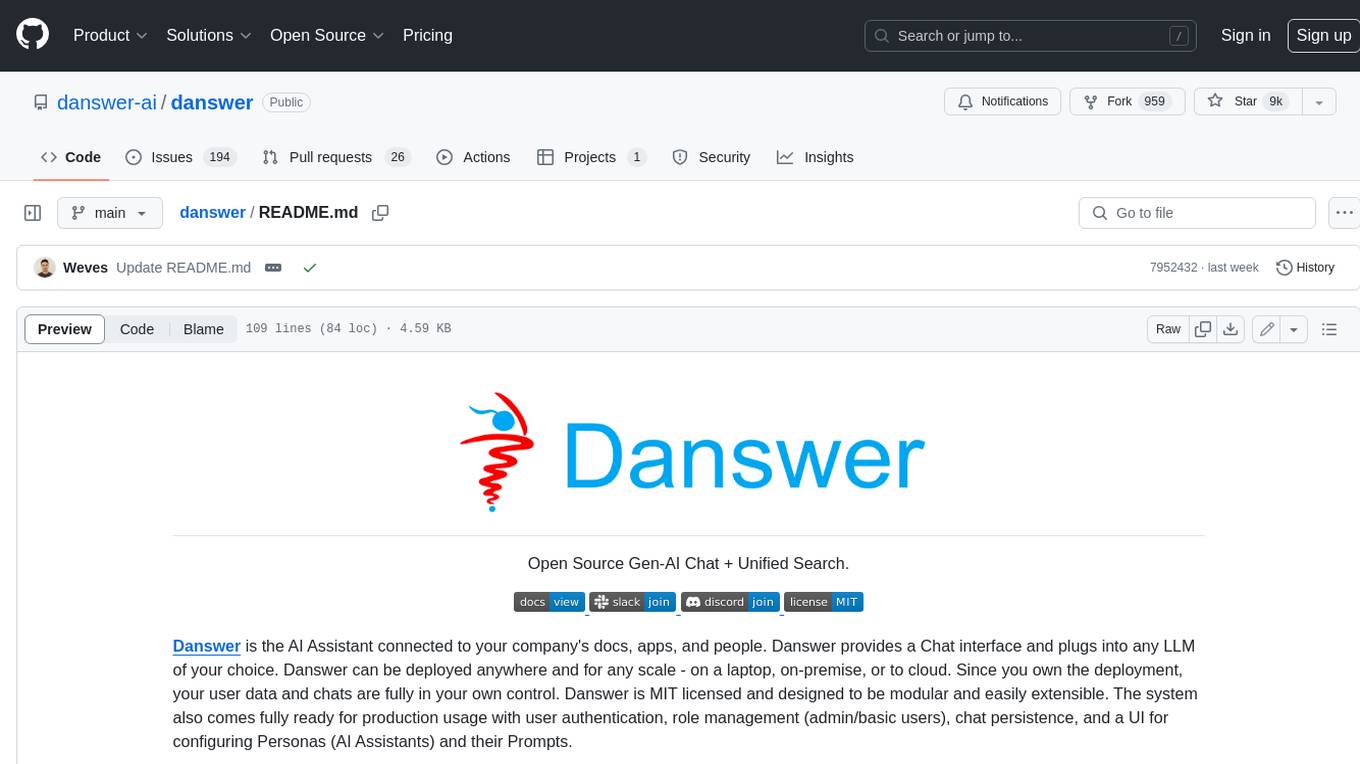
danswer
Danswer is an open-source Gen-AI Chat and Unified Search tool that connects to your company's docs, apps, and people. It provides a Chat interface and plugs into any LLM of your choice. Danswer can be deployed anywhere and for any scale - on a laptop, on-premise, or to cloud. Since you own the deployment, your user data and chats are fully in your own control. Danswer is MIT licensed and designed to be modular and easily extensible. The system also comes fully ready for production usage with user authentication, role management (admin/basic users), chat persistence, and a UI for configuring Personas (AI Assistants) and their Prompts. Danswer also serves as a Unified Search across all common workplace tools such as Slack, Google Drive, Confluence, etc. By combining LLMs and team specific knowledge, Danswer becomes a subject matter expert for the team. Imagine ChatGPT if it had access to your team's unique knowledge! It enables questions such as "A customer wants feature X, is this already supported?" or "Where's the pull request for feature Y?"

infinity
Infinity is an AI-native database designed for LLM applications, providing incredibly fast full-text and vector search capabilities. It supports a wide range of data types, including vectors, full-text, and structured data, and offers a fused search feature that combines multiple embeddings and full text. Infinity is easy to use, with an intuitive Python API and a single-binary architecture that simplifies deployment. It achieves high performance, with 0.1 milliseconds query latency on million-scale vector datasets and up to 15K QPS.
For similar jobs

weave
Weave is a toolkit for developing Generative AI applications, built by Weights & Biases. With Weave, you can log and debug language model inputs, outputs, and traces; build rigorous, apples-to-apples evaluations for language model use cases; and organize all the information generated across the LLM workflow, from experimentation to evaluations to production. Weave aims to bring rigor, best-practices, and composability to the inherently experimental process of developing Generative AI software, without introducing cognitive overhead.

LLMStack
LLMStack is a no-code platform for building generative AI agents, workflows, and chatbots. It allows users to connect their own data, internal tools, and GPT-powered models without any coding experience. LLMStack can be deployed to the cloud or on-premise and can be accessed via HTTP API or triggered from Slack or Discord.

VisionCraft
The VisionCraft API is a free API for using over 100 different AI models. From images to sound.

kaito
Kaito is an operator that automates the AI/ML inference model deployment in a Kubernetes cluster. It manages large model files using container images, avoids tuning deployment parameters to fit GPU hardware by providing preset configurations, auto-provisions GPU nodes based on model requirements, and hosts large model images in the public Microsoft Container Registry (MCR) if the license allows. Using Kaito, the workflow of onboarding large AI inference models in Kubernetes is largely simplified.

PyRIT
PyRIT is an open access automation framework designed to empower security professionals and ML engineers to red team foundation models and their applications. It automates AI Red Teaming tasks to allow operators to focus on more complicated and time-consuming tasks and can also identify security harms such as misuse (e.g., malware generation, jailbreaking), and privacy harms (e.g., identity theft). The goal is to allow researchers to have a baseline of how well their model and entire inference pipeline is doing against different harm categories and to be able to compare that baseline to future iterations of their model. This allows them to have empirical data on how well their model is doing today, and detect any degradation of performance based on future improvements.

tabby
Tabby is a self-hosted AI coding assistant, offering an open-source and on-premises alternative to GitHub Copilot. It boasts several key features: * Self-contained, with no need for a DBMS or cloud service. * OpenAPI interface, easy to integrate with existing infrastructure (e.g Cloud IDE). * Supports consumer-grade GPUs.

spear
SPEAR (Simulator for Photorealistic Embodied AI Research) is a powerful tool for training embodied agents. It features 300 unique virtual indoor environments with 2,566 unique rooms and 17,234 unique objects that can be manipulated individually. Each environment is designed by a professional artist and features detailed geometry, photorealistic materials, and a unique floor plan and object layout. SPEAR is implemented as Unreal Engine assets and provides an OpenAI Gym interface for interacting with the environments via Python.

Magick
Magick is a groundbreaking visual AIDE (Artificial Intelligence Development Environment) for no-code data pipelines and multimodal agents. Magick can connect to other services and comes with nodes and templates well-suited for intelligent agents, chatbots, complex reasoning systems and realistic characters.





